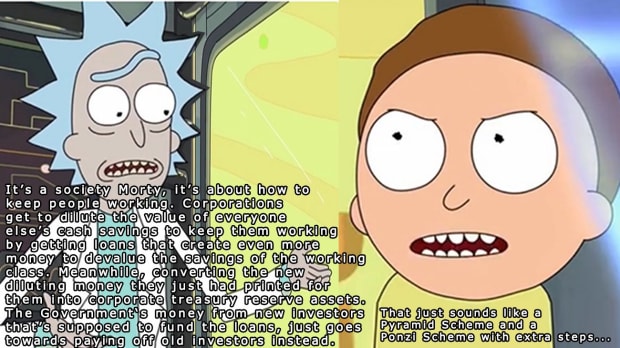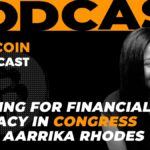The modern financial system is a debt-based pyramid scheme and an investment-based Ponzi Scheme with extra steps.
After a couple of years of studying Bitcoin and the U.S. dollar that I was raised to trust like it was some faceless god, I eventually started valuing everything in Bitcoin’s satoshis instead of the U.S. dollar.
The biggest reason wasn’t because of Bitcoin either. It was the U.S. dollar’s system that did it to me. Once I learned what the system was and how it functioned, I could no longer value anything in dollars after realizing how fast they were exponentially losing value.
The U.S. dollar is a system that is burning up its own value with every new dollar that is digitally issued and shoved into the bank accounts of the top 1% of the world. It is shoved into their accounts whenever they need to get a new bank bailout loan or corporate bond loan. They then take that new money and freeze it into their own portfolio’s asset holdings. Jumping ship from the dollar while the loan/money printing process that got them those dollars melts away the buying power of everyone else’s U.S. dollar savings.
This process leaves almost none of that newly printed money liquidity to trickle down to those at the bottom that are relying on the dollar. Dollars that are perpetually being devalued thanks to the digital printing of trillions of new dollars; trillions of new dollars that are issued through loans acquired by the top 1% for their asset-hoarding greed. And we wonder why the wealth inequality is getting so bad with all this loan welfare. Loan welfare for the top 1% where they get a majority of the newly printed cash to then play musical chairs within their asset market of choice.
They possess most of the now 35% of all U.S. dollars in existence that were digitally printed out of thin air last year, as stated by Jack Choros in a blog post going over the increases in M1 money supply during the pandemic. They always get a majority of the new digitally printed cash every year through loans to hoard in their assets, all while giving employees the bare minimum. Not even the bare minimum to survive anymore, but the bare minimum they can get away with since minimum wage isn’t even enough to afford the new rising costs of rent. NPR covers this in their article: “Rents Are Out Of Reach For Most Americans Earning Minimum Wage.”
That happens because our cash is created with every new loan that gets issued in our current monetary system, as stated by Forbes in “How Bank Lending Really Creates Money, And Why The Magic Money Tree Is Not Cost Free.”
The top 1% can afford to get the largest loans out of all of us. Some of them can even force the government to give them large loans or even buy up their stock, which in turn forces new money to be digitally printed. Devaluing the rest of the dollars in circulation in the process. We saw this during the pandemic. It was covered by The New York Times in their article titled: “1 Percent of P.P.P. Borrowers Got Over One-Quarter of the Loan Money.” According to the article, the 1% of businesses that got the lion’s share of the P.P.P loan money consisted of “powerful law firms like Boies Schiller Flexner, restaurants like the steakhouse chain started by Ted Turner, as well as the operator of New York’s biggest horse tracks.”
The government is often forced to give out these massive corporate loans that cause the printing of new money which devalues everyone’s U.S. dollar savings. There are situations like this that we see every couple of years where banks need to get bailed out because their corrupt systems go bust and start falling apart, further increasing the debt imbalance on the U.S. dollar’s balance sheet.
To see examples of these forced loans and forced stock buying programs for the largest banks and corporations of the world, all we have to do is look back to the same 2008 bailouts that caused Satoshi to invent Bitcoin in the first place. Wikipedia has a page detailing the events well, listing all the beneficiaries of the bailout in their page named the “Troubled Asset Relief Program.” A program that was created because banks and corporations marketed themselves as “Too Big To Fail.” In other words, using unproven theories about how their own failures caused by their own mistakes would somehow cause the whole financial system to crash, all to scare the general public and their lobbied politicians into bailing them out with programs that print new dollars just for them. These bailouts charge anyone saving in dollars an invisible tax via the inflation those bailouts cause. Wikipedia also has a page covering this that explains it in the following words: “Inflation tax It is a hidden regressive tax. Financial repression A range of measures which governments can employ to reduce their debt, which are often accompanied by inflation.”
Another part of this money printing picture for the top 1% is “Corporate welfare programs.” Programs in which governments hand out money grants, tax breaks and other special favorable treatment to corporations in the top 1% of the financial world.
The U.S. dollar’s system in which new dollars are generated through loans is basically a loan-based, asset-hoarding pyramid scheme with extra steps. One that is falling apart at increasingly faster rates with every uptick in inflation, and no uptick in wages thanks to the wage stagnation caused by corporate greed. Corporate greed likes to test how little they can get away with paying people while avoiding an uprising.
It falls apart further with every new digitally printed dollar that forces them to print even more dollars to pay off old debts, which in turn creates larger debts in the process. Repeating this bleeding debt, money creation cycle that is causing the inflationary purchasing power loss of the U.S. dollar to grow exponentially faster over time.
All this so 1% of the population can hoard enough assets to live like financial gods. With enough money to fly their rockets to the heavens and still have more money left over than they can ever possibly spend in their lifetimes. But sure, some of them are promising to give it all away when they die, so they tell us that it’s okay for them to do it.
Their corrupt schemes get more fun, too, on the other end of this debt/money creation equation: the investor’s end.
On the investor’s end, the government pays off debts to old national bond investors with the money they receive from new national bond investors that are investing into the government’s bond market system.
That means that the U.S. pays off old investors of the nation with the money they receive from new investors into the nation’s bond system. Sound familiar? In the dictionary, this is called a Ponzi scheme. I call it “a Ponzi scheme with extra steps.”
These government bond investors are supposed to be the ones funding the new government bond loans. But there are not enough investors to do that, since most people today are wage slaves. So, the investors that are able to invest can only afford to fund a small percentage of the massive corporate-government loans that get approved every year. Meaning the rest is new money printed out of thin air with each loan that exceeds the national bond investment cash inflow.
They print the new money that devalues the purchasing power of everyone else’s U.S. dollar savings, while at the same time freezing the new money supply in corporate assets that prevents it from trickling down and circulating throughout the economy: This system is how a wage slave working class is created.
A working class with wages so low that they can never save any substantial amount of money before the dollars in their savings are devalued beyond any meaningful utility. Usually forcing them to have no other option but to take on unpayable debts just to get by and get anything they need in life like a house, a car, food, or rent, or even to pay emergency medical bills.
The national bond investor end of this equation is what allows the government the front they need to be able to print the massive amounts of money that they do. Money that they then loan to Wall Street every year who then freezes it into their asset bags.
You know, like how a money-laundering operation works. Except, instead of the money coming in from cartels or nefarious businesses with offshore bank accounts to then be washed through their fake businesses and stored in legal assets, it’s just being printed out of thin air by the Federal Reserve. Adding more dollars to the overall circulating dollar supply, while reducing the value of everyone else’s savings who save in U.S. dollars and/or fiat currencies like it that rely on the dollar.
Have you felt that something was off with our financial system in this country? That might be because you subconsciously noticed that the system unfairly flows the stream of new money to the top 1%. While at the same time leaving those at the bottom with less money and only higher debts every year that perpetually grows and forces them to work all their lives.
In layman’s terms, the system is a debt-based pyramid scheme with extra steps, fronted on the other end by an investing-based Ponzi scheme with extra steps.
George Carlin said it best: “It’s a big club, and you ain’t invited.”
Everyone else might as well be a WestWorld robot-like wage slave whose time can be rented and traded with a paycheck like a deck of trading cards.
It’s two sides of the same rotten apple, and it is starting to rot down to the core. Two corrupt practices that the government takes other companies and individuals down for when they’re caught doing it. Maybe they just don’t like the competition. Maybe it’s Maybelline. (Sorry, I couldn’t help myself!)
When Bernie Madoff gave his first interview from jail after being caught running a Ponzi scheme, he told the press: “Why are you even talking to me; the federal government is running the biggest Ponzi scheme in the world!”(Paraphrased from NBS News: “Madoff: ‘Whole government is a Ponzi scheme‘”)
If there was one thing Maddoff was an expert in, it was Ponzi schemes. Game recognizes game.
All this is inching the U.S. dollar closer to a cliff of hyperinflation. A financial cliff drop in the dollar’s purchasing power that most of us now have a high probability of seeing in our lifetimes.
When we compare where our debt-to-balance ratio is today to other countries in history who have been where we are now. Each of those countries historically fell into hyperinflation within 30 years from when they were at the point we’re at now. Unsustainable increases in inflation rates, which caused a loaf of bread to cost their citizens upward of a million dollars in their currencies.
Where Venezuela is today. Where Argentina, Zimbabwe, and so many more countries are today. All countries who are already experiencing this ahead of us 30 years ago were, 30 years ago, where we are today in our rates of inflation and national debt balance sheets.
It happened to Germany before they got desperate and fell into wars from the pains of those economic collapses. Wars that were started as last-ditch efforts to save their country. Well, more so to save the wallets of the country’s political leaders and its war profiteering military industrial complex.
The fall of these countries’ currencies always started off with a slow ramp-up in speed like what the U.S. had in 2008, when Satoshi first noticed it during the second bank bailouts. That’s right, the first bank bailouts were done in the late 1990s, and almost nobody paid attention. Next follows a moderate-to-fast increase in speed like we are in now. All finally resulting in one giant uncontrollable drop in the values of their currencies within 30 years. A value-loss rate of inflation that never ended once they fell into hyperinflation.
And with the U.S. dollar being the reserve currency of most countries today, then its collapse will drag the whole world down with it if they all don’t hedge themselves properly to protect themselves against the dollar’s approaching collapse.
El Salvador is a great example of that kind of hedging against the dollar that other countries appear to be taking notes on. If you don’t know, El Salvador made bitcoin a legal currency and treasury reserve asset in their country to protect themselves against the dollar’s increasing rate of inflation.
The signs of the dollar’s collapse and that it’s exponentially picking up speed is obvious when you look at all countries that are experiencing hyperinflation today. Countries that relied on the dollar until its increasing rates of inflation failed them and their currencies. This is further explained in Robert Kiyosaki’s video, “Shocking Prediction: The Price of Bitcoin by 2031.”
Because of all that, I’m more afraid to save dollars long term than I am afraid to save bitcoin. Especially after reading the charts on https://wtfhappenedin1971.com/.
It really paints a good picture of how we started heading down this increasing rate of inflation rabbit hole after Nixon ended the gold standard. Something that even Nixon said was supposed to be temporary. Well, it’s been 50 years since then and the dollar has only lost what? Over 99% or more of its value when compared to things like houses, cars, food or rent. But sure, it’s temporary.
If you want to know why I’m bullish on bitcoin, and why I started using it as my primary savings ever since learning about its system instead of the U.S. dollar then check out my article, “My Best Attempt To Simplify The Math Of A $50 Million Dollar Bitcoin.”
This is a guest post by Fausto Liro. Opinions expressed are entirely their own and do not necessarily reflect those of BTC, Inc. or Bitcoin Magazine.





 BTC-USD
BTC-USD  ETH-USD
ETH-USD  LTC-USD
LTC-USD  XRP-USD
XRP-USD